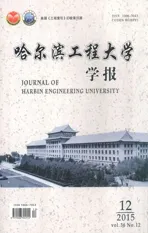乘员约束系统参数筛选与正交试验优化设计
2015-02-18田晟
田晟
(华南理工大学 土木与交通学院,广东 广州 510640)
乘员约束系统参数筛选与正交试验优化设计
田晟
(华南理工大学 土木与交通学院,广东 广州 510640)
摘要:为了在汽车碰撞测试中获得较高的分值,需要对乘员约束系统进行参数筛选与优化设计。初步挑选出对乘员约束系统影响较大的7个参数,然后由WIC加权法则、一阶响应面法结合7因素2水平的正交试验设计筛选出4个优化设计参数即排气孔面积A、限力值L、安全带延伸率B和预紧力N。再采用4因素5水平的正交试验优化这4个设计参数,因正交试验不是全面试验,对试验结果采取直接观察找出的组合不能完全保证就是最优组合,所以需要进行极差分析和方差分析。由极差分析法和方差分析法综合权衡后选择最优组合A5L1B1N5,比较了优化前后的假人x向胸部减速度等图形曲线,结果表明:WIC和HIC等主要伤害指标值得到下降,同时胸部x向减速度峰值与设计计算的峰值接近;优化后的乘员约束系统性能得到了明显的改善。
关键词:正面碰撞;乘员约束系统;正交试验设计;参数筛选;优化设计
网络出版地址:http://www.cnki.net/kcms/detail/23.1390.U.20151105.0910.002.html

乘员约束系统是指在汽车碰撞事故中对乘员起保护作用的装置,包括安全带、安全气囊、安全座椅、吸能式转向管柱与转向盘、软化的内饰件等[1-2],乘员保护系统中最早采用安全带,在车辆发生前撞及翻滚时约束乘员相对于车辆的运动,对保护乘员能起到显著的效果[3]。安全气囊也常常用来保护车内的乘员,它与安全带的联合使用可对乘员进行有效的保护[4-5]。为了保护乘员舱的乘员,需要避免乘员与舱内部件发生二次碰撞,良好的乘员约束系统通过优化设计后能够与假人和车体合理匹配[6-9]。例如YANG Yang等研究了人车较好地匹配耦合后具有较低的碰撞伤害[10],YANCHAR等调查了加拿大某地区居民对儿童乘员约束系统安全知识的掌握和实际运用的差异并给出了建议[11],吴俊通过儿童乘员约束系统模型得到影响6至12岁儿童乘员损伤的显著性参数,并提出该年龄段儿童的约束系统最佳设计[12]。李勇等研究证实乘员约束系统的参数都存在一个合理的数值或范围,能显著减轻对乘员的伤害[13]。由此可见乘员约束系统参数的选择和优化设计是汽车正面碰撞安全设计的关键问题之一,本研究采用正交试验设计对乘员约束系统进行参数筛选和优化设计。
1乘员约束系统参数的选择
乘员约束系统包括安全带、安全气囊、座椅等部件,而每一部件又包含不同的特征参数。根据工程经验,选择表1中7个设计变量作为乘员约束系统的基本参数,表1中还列出7个设计参数的变化范围。

表1 设计参数变化范围Table 1 Variation range of design parameters
1990年通用公司的Viano和Arepally[14]引入加权因子,将各项伤害指标用加权的方法综合到一起,来评价人体伤害程度,即采用加权伤害准则WIC (weighted injury criterion)来全面评价乘员约束系统的性能,WIC值越低,说明约束系统的保护性能越好;反之,则越差。WIC计算式为
(1)
式中:HIC(head injury criterion)为头部综合性能指标,C3ms为胸部3 ms加速度值,Ccomp为胸部压缩量,FFL为左大腿最大轴向压力,FFR为右大腿最大轴向压力。式中每项指标前的权系数表明了该种伤害类型的重要程度,而重要程度则来自于对大量事故的统计分析和仿真模拟,例如兰凤崇等[15]建立生物力学有限元仿真模型评价人体胸-腹部损伤程度。
根据7个设计参数对WIC值的影响程度以及工程经验,选择排气孔面积A、限力值L、安全带延伸率B、预紧力N作为优化设计的参数。
2乘员约束系统优化设计
选出4个参数(即4因素)作为乘员约束系统优化设计变量后,考虑在初始值上下对称变化4次即得到5个水平数如表2所示,这是一个4因素5水平的正交试验设计,选取正交表L25(56)。

表2 4因素5水平表Table 2 Four factors and five levels


表3 乘员约束系统伤害指标输出结果Table 3 Injury indexes output results of occupant restraint system

2.1 极差分析

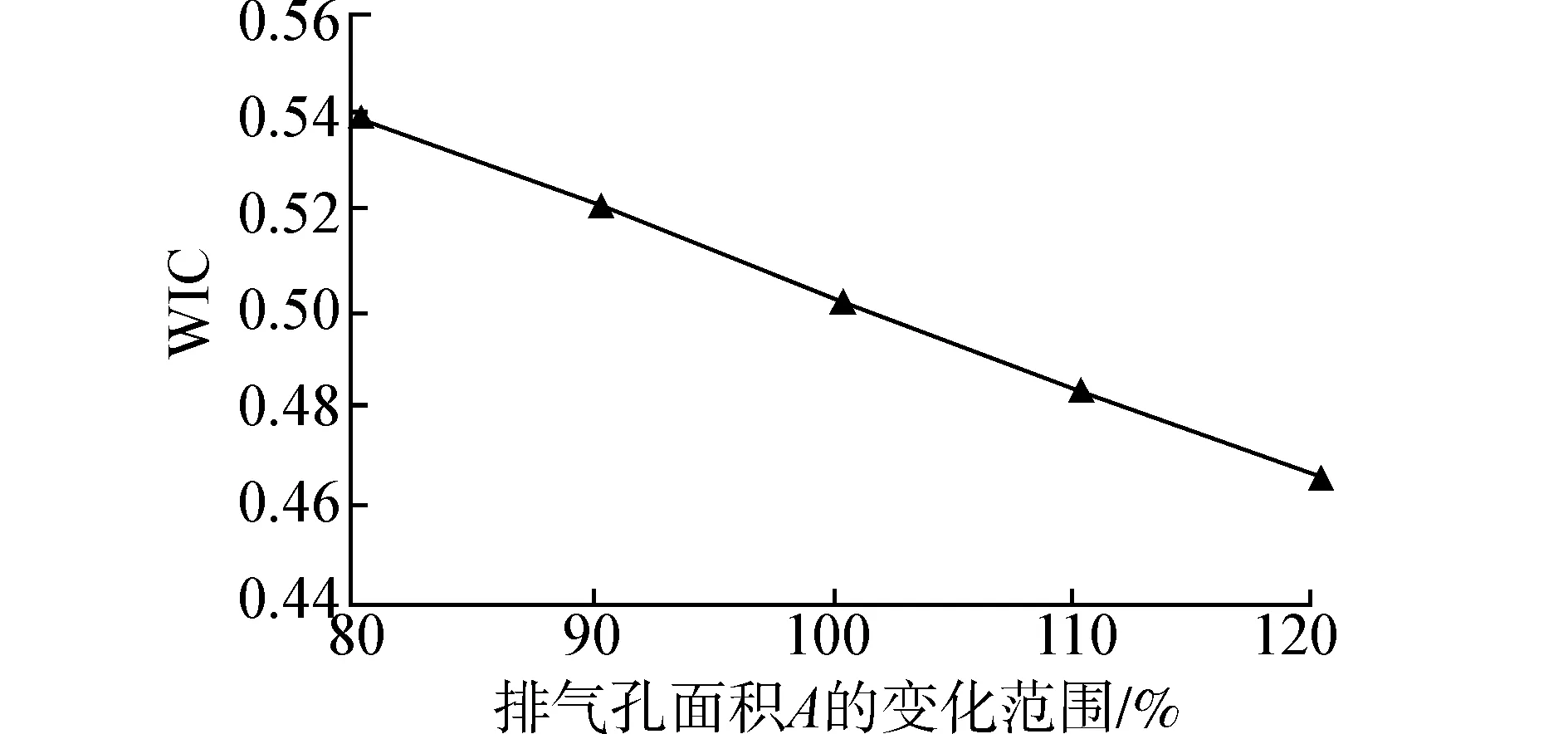
(a)排气孔面积A

(b)限力值L

(c)安全带延伸率B
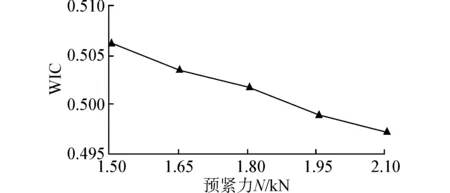
(d)预紧力值N 图1 各因素与WIC的关系Fig.1 Relationship between WIC and optimization parameters

(a)排气孔面积A

(b)限力值L
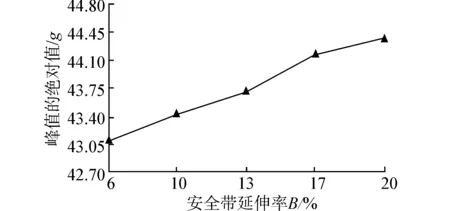
(c)安全带延伸率B

(d)预紧力值N图2 各因素与胸部x向减速度峰值omax的关系Fig.2 Relationship between omaxand optimization parameters
由表4得出,按照Rj从大到小排列,4个因素对WIC的影响程度从大到小的排列顺序为排气孔面积A、预紧力N、限力值L、安全带延伸率B。由表4和图1得出各因素的水平最优组合为A5L1B1N5。
表4以WIC为目标的极差分析表
Table 4Range analysis for WIC
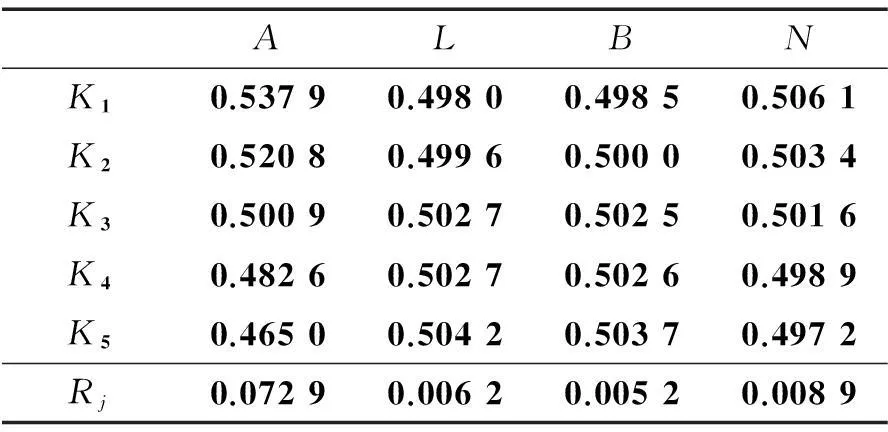
ALBNK10.53790.49800.49850.5061K20.52080.49960.50000.5034K30.50090.50270.50250.5016K40.48260.50270.50260.4989K50.46500.50420.50370.4972Rj0.07290.00620.00520.0089


表5 以omax为目标的极差分析表Table 5 Range analysis for omax
WIC是直接反映乘员约束系统的性能指标,前面提到WIC越小表明乘员约束系统性能越好。图1显示出随着A和N的增大,WIC的趋势反而减小;图1同时显示出随着L和B的增大,WIC的值也随着增大;即图1总体反映了WIC随着各个因素变化的趋势,然而A、L、B和N这4个因素变化程度对WIC的影响还需要进一步分析。
2.2 方差分析

通过表6和表7,可以得出如下分析结果:

表6 WIC方差分析表Table 6 Variance analysis for WIC

表7 胸部x向减速度峰值方差分析表Table 7 Variance analysis for omax
1)从表6得出各因素对WIC(反映乘员约束系统性能)的影响,按从大到小的顺序排列:排气孔面积A、预紧力N、限力值L、安全带延伸率B,即调整A的大小对WIC影响最大,也与极差分析的结果一致,同时也看到这4个因素都与WIC显著相关或高度显著相关,说明选择这4个因素作为乘员约束系统优化设计参数是合适的。


综上所述,优化的候选方案包括A5L2B1N5、A5L1B1N5、A4L4B2N5,其中A5L2B1N5和A4L4B2N5即是表3中22号方案和19号方案(表3中黑体显示),而A5L1B1N5组合没有出现在表3中,需要重新在MADYMO(mathematical dynamic model)模型里仿真计算,结果如表8所示,且与优化前的方案(0号方案)、19号和22号方案进行比较。


表8 方案比选Table 8 Choosing scheme
由MADYMO 后处理分别输出优化前后的左右大腿轴向受力曲线,胸部x向减速度曲线、胸部合成加速度曲线,头部合成加速度和胸部压缩量曲线,如图3~5所示。

(a)左大腿

(b)右大腿图3 左右大腿轴向受力优化前后对比Fig.3 Force comparison of left and right femurs before and after optimization

(a)胸部x向减速度
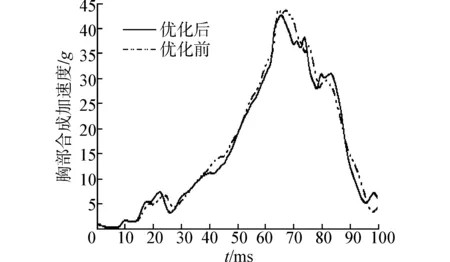
(b)胸部合成加速度图4 胸部x向减速度和合成加速度优化前后对比Fig.4 Chest deceleration(x) and resultant acceleration comparison before and after optimization

(b)胸部压缩量图5 头部合成加速度和胸部压缩量优化前后对比Fig.5 Head resultant acceleration and chest compression comparison before and after optimization
3结论
1)在乘员约束系统参数筛选中,通过WIC加权法则和正交试验设计,综合考虑之后选出排气孔面积A、限力值L、安全带延伸率B和预紧力N作为4个优化设计参数;
2)采用4因素5水平的正交试验优化设计该4个参数,选择比较接近-42.2g的胸部x向减速度峰值,由极差分析法和方差分析法综合权衡后选择最优组合为A5L1B1N5;
3)利用MADYMO后处理软件输出优化前后的假人x向胸部减速度等6个图形曲线;
4)优化结果表明:正面碰撞乘员伤害WIC值降低了8.67%,约束系统性能得到了优化改善,同时优化后的假人x向胸部减速度峰值等于-42.28g,最接近设计计算峰值-42.2g。
参考文献:
[1]LEE E L, HAYES W C. Occupant accelerations and injury potential during an ambulance-to-curb impact[J]. Forensic Science International, 2014, 237: e6-e10.
[2]BEEMAN S M, KEMPERA A R, MADIGAN M L, et al. Occupant kinematics in low-speed frontal sled tests: Human volunteers, Hybrid III ATD, and PMHS[J]. Accident Analysis and Prevention, 2012, 47: 128-139.
[3]VAN HOUTEN R, REAGAN I J, HILTON B W. Increasing seat belt use: Two field experiments to test engineering-based behavioral interventions[J]. Transportation Research Part F: Traffic Psychology and Behaviour, 2014, 23: 133-146.
[4]KHOUZAM R N, AL-MAWED S, FARAH V, et al. Next-generation airbags and the possibility of negative outcomes due to thoracic injury[J]. Canadian Journal of Cardiology, 2014, 30(4): 396-404.
[5]LU Huizhen, ANDREEN M, FAUST D, et al. Safety belt and occupant factors influencing thoracic and upper abdominal injuries in frontal crashes[C]//SAE Technical Paper 2011-01-1129, 2011.
[6]RYB G E, DISCHINGER P C, KLEINBERGER M, et al. Aortic injuries in newer vehicles[J]. Accident Analysis and Prevention, 2013, 59: 253-259.
[7]ADAM T, UNTAROIU C D. Identification of occupant posture using a Bayesian classification methodology to reduce the risk of injury in a collision[J]. Transportation Research Part C: Emerging Technologies, 2011, 19(6): 1078-1094.
[8]WEAVER A A, DANELSON K A, ARMSTRONG E G, et al. Investigation of pulmonary contusion extent and its correlation to crash, occupant, and injury characteristics in motor vehicle crashes[J]. Accident Analysis and Prevention, 2013, 50: 223-233.
[9]KOPPEL S, MUIR C, BUDD L, et al. Parents’ attitudes, knowledge and behaviours relating to safe child occupant travel[J]. Accident Analysis & Prevention, 2013, 51: 18-26.
[10]YANG Yang, LIOU W W, SHENG J, et al. Shock wave impact simulation of a vehicle occupant using fluid/structure/dynamics interactions[J]. International Journal of Impact Engineering, 2013, 52: 11-22.
[11]YANCHAR N L, KIRKLAND S A, LEBLANC J C, et al. Discrepancies between knowledge and practice of childhood motor vehicle occupant safety in Nova Scotia——A population-based study[J]. Accident Analysis and Prevention, 2012, 45(3): 326-333.
[12]吴俊. 后排儿童乘员碰撞损伤防护研究[D]. 长沙: 湖南大学, 2013: 34-83.WU Jun. The research on the injury prevention of child occupant seated on the rear seat[D]. Changsha: Hunan University, 2013: 34-83.
[13]李勇, 胡宁. 汽车正面碰撞驾驶员胸部损伤影响因素分析[J]. 汽车工程, 2011, 33(7): 598-602.LI Yong, HU Ning. An analysis on the factors affecting driver's thoracic injury in vehicle frontal crash[J]. Automotive Engineering, 2011, 33(7): 598-602.
[14]VIANO D C, AREPALLY S. Assessing the safety performance of occupant restraint systems[C]//SAE Technical Paper 902328, 1990.
[15]兰凤崇, 蔡志华, 陈吉清, 等. 汽车碰撞中胸-腹部的生物力学响应与损伤评价[J]. 华南理工大学学报:自然科学版, 2012, 40(12): 70-78.LAN Fengchong, CAI Zhihua, CHEN Jiqing, et al. Biomechanical responses and injury evaluation of human thorax and abdomen during vehicle collision[J]. Journal of South China University of Technology: Natural Science Edition, 2012, 40(12): 70-78.
Parameter selection and orthogonal experimental
optimization design for an occupant restraint system
TIAN Sheng
(School of Civil Engineering and Transportation, South China University of Technology, Guangzhou 510640, China)
Abstract:In order to obtain better scores in car crash tests, an occupant restraint system needs parameter selection and optimization design. Here, seven initial parameters which have greater influence on an occupant restraint system are chosen. Then four optimization design parameters, namely vent area A, load limit L, seat belt extension ratio B, and pretension force N, are selected by the weighted injury criteria (WIC) rule, the first-order response surface method, and the orthogonal test design of seven factors and two levels. The four parameters are optimized using an orthogonal test design of four factors and five levels. Because the orthogonal test is partly done, direct observation of the test results shows the combination cannot fully guarantee an optimal combination, it needs to do range analysis and variance analysis. The optimal combination A5L1B1N5is chosen comprehensively by range analysis and variance analysis. Comparing some graphics curves, including dummy chest deceleration(x), before and after optimization, shows that the main harm index values such as WIC and HIC decrease. At the same time, the dummy chest deceleration(x) peak value approaches the peak value of the design calculation. The optimized performance of the occupant restraint system is obviously improved.
Keywords:full frontal impact; occupant restraint system; orthogonal experimental design; parameters selection; optimization design
通信作者:田晟,E-mail:shitian1@scut.edu.cn.
作者简介:田晟(1969-), 男, 副教授,博士.
基金项目:国家科技支撑计划资助项目(2011BAG02B02).
收稿日期:2014-10-20.网络出版日期:2015-11-05.
中图分类号:U461.91
文献标志码:A
文章编号:1006-7043(2015)12-1565-06
doi:10.11990/jheu.201410035
